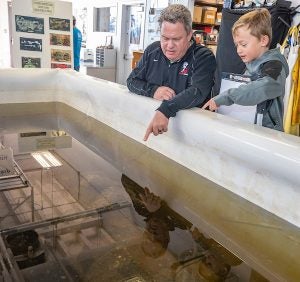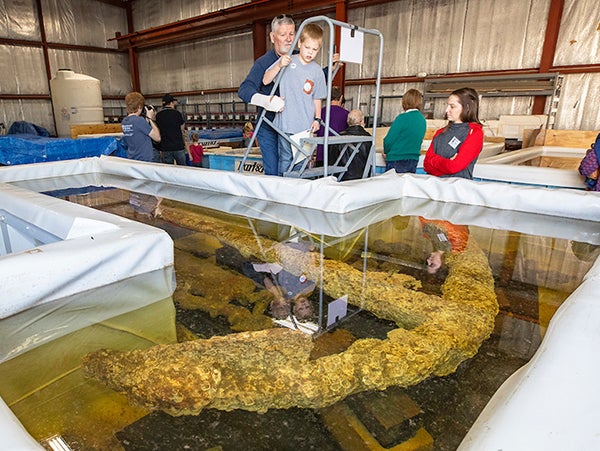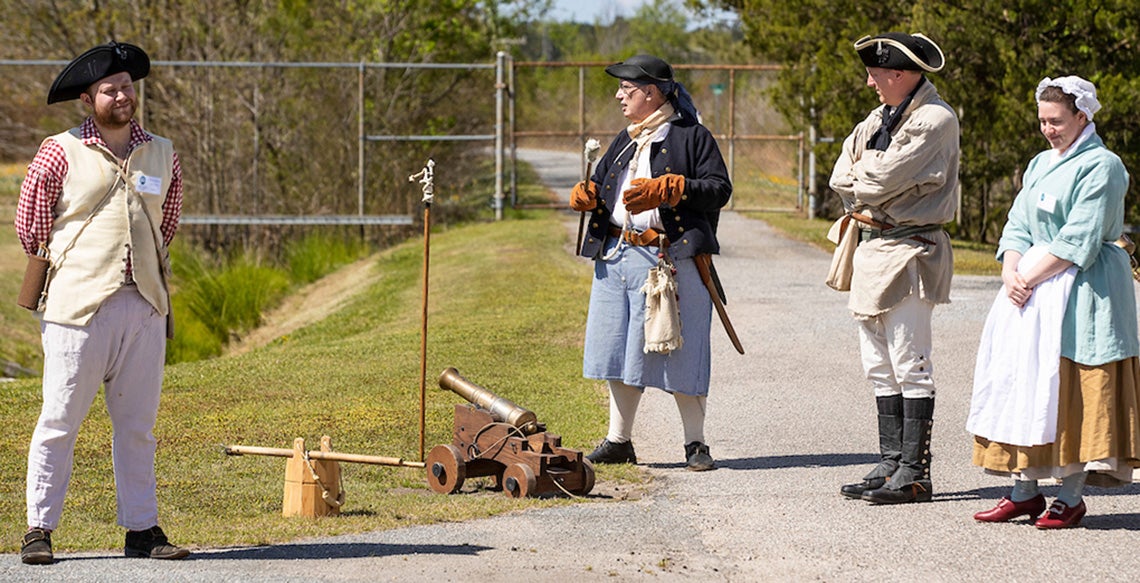SCIENCE AND PIRATES
Open house marks 300th anniversary of Blackbeard’s shipwreck
FIRE!
The blast of a cannon ripped through the air to the delight of onlookers outside the Queen Anne’s Revenge Conservation Laboratory at East Carolina University during the fourth annual Blackbeard: The Science of Pirates open house.
This year’s event marks the 300th anniversary of the grounding of the Queen Anne’s Revenge and Blackbeard’s death. The wreck and its artifacts lay submerged for more than 250 years until its discovery near Beaufort Inlet in 1996. Since then, parts of the ship, weapons and items from daily life aboard the ship have been recovered and brought to ECU for cleaning, desalination, consolidation, drying and analysis.

Kevin Morse, left, and Grayson Morse look at Cannon No. 16.
Approximately 420,000 artifacts have been brought up from the sea floor and are in various stages of conservation — some still encased in concretion, a mineral cement that forms especially around iron objects, and others fully conserved and on display at the N.C. Maritime Museum in Beaufort.
“Blackbeard: The Science of Pirates is our opportunity to share a little-known STEM field with the public, as well as teach people how we preserve our shared cultural heritage. Not many people realize we’re here in Greenville, and that we are conserving such a historic shipwreck,” said Courtney Page, QAR Lab manager.
The annual open house is part of the N.C. Science Festival, a two-week celebration of science featuring events across the state. The theme of this year’s festival is food and drink, so the QAR lab displayed a selection of the foods that would have been aboard the ship during a voyage.
There also were hands-on activities where visitors could test the pH of different solutions, map artifacts on an archaeological site, test knot-tying skills and touch a cannon that was last fired by pirates. One of the most popular stations was a demonstration of the process of breaking down concretions using a cookie.
“The toothpick is the air scribe, which is the tool that we use to break down our concretions. And the cookie itself is the concretion, and the M&Ms are the artifacts,” said Kim Urban, archaeological technician with the N.C. Department of Natural and Cultural Resources, which oversees the QAR conservation project. “So they have to use the toothpick to get the M&Ms out without breaking them. And then they get to eat it.
“Unfortunately we don’t get to eat our artifacts after we break them down,” she added.
The lab offers unparalleled opportunities for students at ECU who are interested in archaeology and conservation.
“We are one of a handful of maritime archaeological conservation labs in the country, and we provide both training and exposure for ECU students. We give tours of the lab, lectures in classes, and accept volunteers interested in learning more,” Page said.
It was the opportunity to see the artifacts in person that brought John Stokes and his 9-year-old grandson, John Strickland, to the QAR Lab. Strickland has seen cannons in videos about pirates, but “I’ve never seen the actual cannons in life,” he said.

John Stokes and his grandson, John Strickland, came to get a firsthand look at artifacts from the Queen Anne’s Revenge, like this anchor weighing almost 2,000 pounds.
Stokes said his grandson is fascinated by pirates in general and Blackbeard specifically, because of the legendary pirate’s local connections.
“I like the history about old things, like Queen Anne’s Revenge,” Strickland said. “I’ve watched a few things and heard a few myths or truths. Some people think he purposely sank it, some people think he didn’t, and I’ve heard that when they first found the cannons, they were filled, loaded and everything like they were going into battle.”
There are 17 cannons currently at the lab, including one that is fully conserved and will soon be moved to the museum. On the large end of the spectrum there’s also a large anchor weighing nearly 2,000 pounds, while at the small end there are thousands of fragments, bits and pieces representing everyday life, such as pieces of ceramic from cookware and containers. There are even miniscule amounts of gold dust.
“We’re making new discoveries all the time,” said Sarah Watkins-Kenney, director of the QAR Lab. “It’s part of our history, it brings together science and history and ecology, and there’s something in it for everybody.”
The event also served as the unveiling for a major new piece of equipment in the lab’s warehouse, an overhead bridge crane that will enable conservators to move large artifacts more readily. The installation was funded by a Maritime Heritage Grant from the National Parks Service. Before the crane was installed, a manual gantry was used to move cannons, anchors and other large artifacts.
“It could take two hours to move a cannon,” Watkins-Kenney said. “Now it’s done with the push of a button.”
The annual open house is intended to allow visitors to be a conservator for a day and learn how chemistry, physics and technology are used to learn more about what life was like on a pirate ship three centuries ago.
“Blackbeard, himself, is such an enigma. We know so little about the actual man, and yet he is arguably the most notorious pirate of the Golden Age,” Page said. “The mystery and intrigue are exciting, and I think people can identify with the desire to abandon a life of rules and just sail the seas doing whatever you please.
“For North Carolina, he is seen as ‘our’ pirate, having spent so much of the time we do know about his life on our shores. He certainly left behind a legacy within our state that can be seen in place names, festivals and even genealogy. And for ECU, he is the real Pirate of ECU!”

The gun crew prepares a carriage gun for firing during a weapons demonstration.
